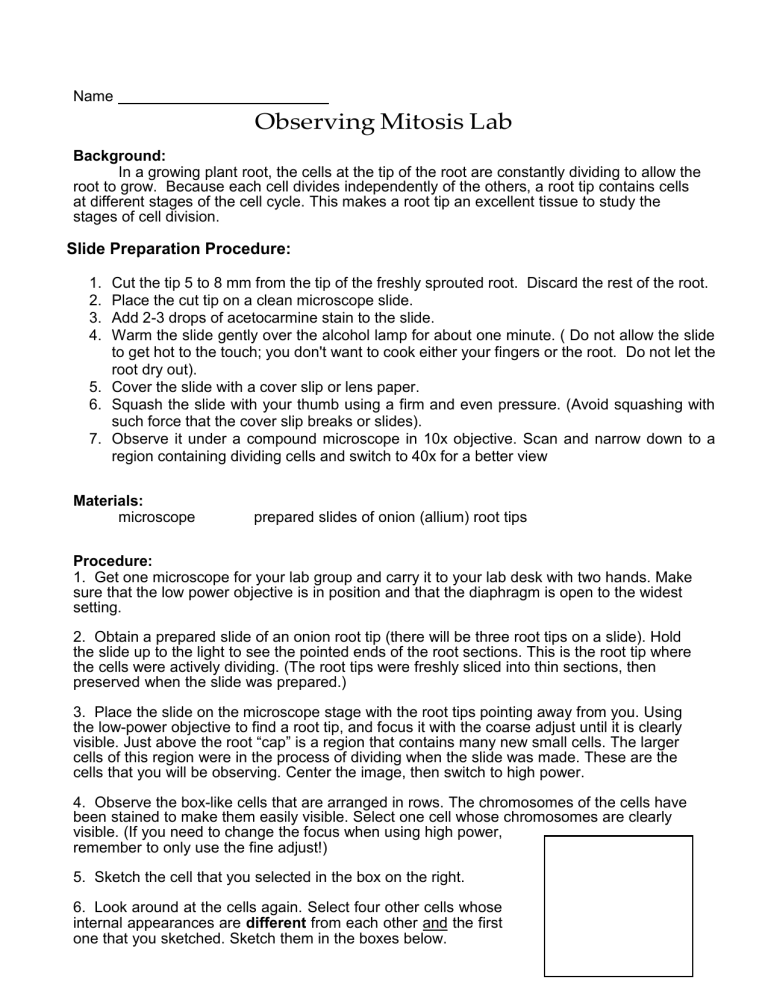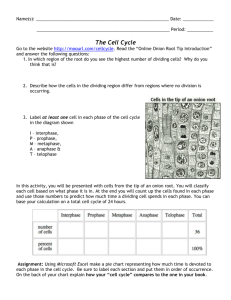
Name Observing Mitosis Lab Background: In a growing plant root, the cells at the tip of the root are constantly dividing to allow the root to grow. Because each cell divides independently of the others, a root tip contains cells at different stages of the cell cycle. This makes a root tip an excellent tissue to study the stages of cell division. Slide Preparation Procedure: 1. 2. 3. 4. Cut the tip 5 to 8 mm from the tip of the freshly sprouted root. Discard the rest of the root. Place the cut tip on a clean microscope slide. Add 2-3 drops of acetocarmine stain to the slide. Warm the slide gently over the alcohol lamp for about one minute. ( Do not allow the slide to get hot to the touch; you don't want to cook either your fingers or the root. Do not let the root dry out). 5. Cover the slide with a cover slip or lens paper. 6. Squash the slide with your thumb using a firm and even pressure. (Avoid squashing with such force that the cover slip breaks or slides). 7. Observe it under a compound microscope in 10x objective. Scan and narrow down to a region containing dividing cells and switch to 40x for a better view Materials: microscope prepared slides of onion (allium) root tips Procedure: 1. Get one microscope for your lab group and carry it to your lab desk with two hands. Make sure that the low power objective is in position and that the diaphragm is open to the widest setting. 2. Obtain a prepared slide of an onion root tip (there will be three root tips on a slide). Hold the slide up to the light to see the pointed ends of the root sections. This is the root tip where the cells were actively dividing. (The root tips were freshly sliced into thin sections, then preserved when the slide was prepared.) 3. Place the slide on the microscope stage with the root tips pointing away from you. Using the low-power objective to find a root tip, and focus it with the coarse adjust until it is clearly visible. Just above the root “cap” is a region that contains many new small cells. The larger cells of this region were in the process of dividing when the slide was made. These are the cells that you will be observing. Center the image, then switch to high power. 4. Observe the box-like cells that are arranged in rows. The chromosomes of the cells have been stained to make them easily visible. Select one cell whose chromosomes are clearly visible. (If you need to change the focus when using high power, remember to only use the fine adjust!) 5. Sketch the cell that you selected in the box on the right. 6. Look around at the cells again. Select four other cells whose internal appearances are different from each other and the first one that you sketched. Sketch them in the boxes below. 7. As you look at the cells of the root tip, you may notice that some cells seem to be empty inside (there is no dark nucleus or visible chromosomes). This is because these cells are three dimensional, but we are looking at just thin slices of them. (If you slice a hard boiled egg at random, would you definitely see the yolk in your slice? No.) We want to continue to look at the cells, but we will ignore any where we cannot see the genetic material (dark areas). 8. Looking along the rows of cells, identify what stage each cell is in. Use the photos below as guide. Interphase Prophase Metaphase Anaphase Telophase (dark mass) (chromosomes visible but not organized) (chromosomes lining up along equator) (pulling apart) (two nuclei) 9. Use the data table to record the number of cells that you see in each of the stages. The easiest way to do this is for one person to look through the microscope, going along each row of cells. For each cell, say out loud what stage the cell appears to be in. Another student can make tally marks for each stage. Stage of Cell Cycle Interphase Prophase Metaphase Anaphase Telophase Number of cells in the Stage: Analysis & Conclusions: 1. What stage were the majority of the cells in? 2. What percentage of the cells were in each stage? Interphase Prophase Metaphase Anaphase Telophase 3. What evidence shows that mitosis is a continuous process, not a series of separate events? 4. The onion plant began as a single cell. That cell had X number of chromosomes. (The exact number does not matter, we will just call that number “X”.) How many chromosomes are in each of the cells that you observed? (Give the answer in terms of X.) How do you know? 5. If this onion would reproduce sexually, it would need to produce sperm and/or eggs by the process of meiosis. After meiosis, how many chromosomes would be in each sex cell (in terms of X)? 6. If this onion would complete the process of sexual reproduction (fertilizing an egg cell), how many chromosomes would be in the zygotes that are produced (in terms of X)?





